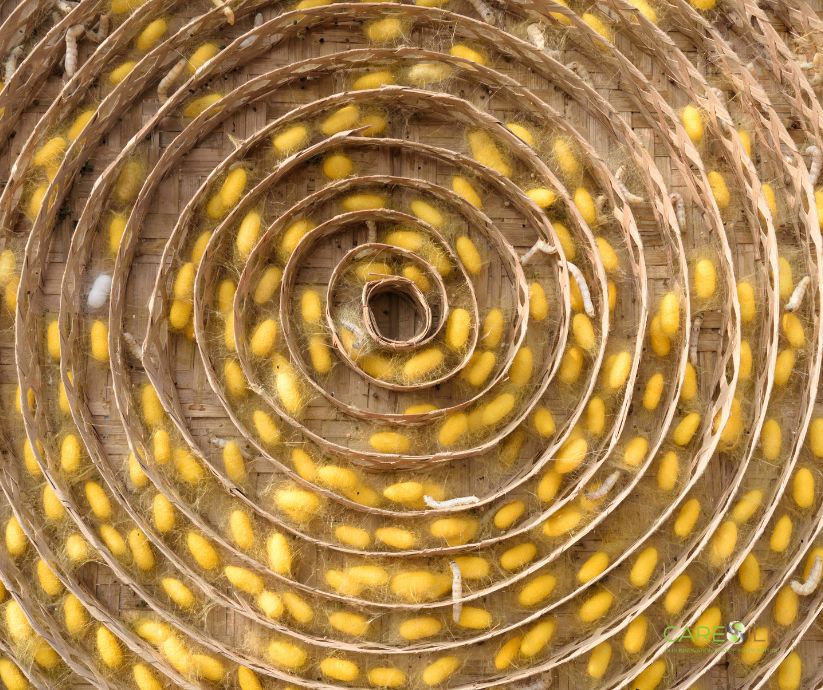Sericulture begins with the careful selection of Bombyx mori eggs, which must come from genetically pure strains selected for high-quality silk production. The eggs must be stored in refrigerators at controlled temperatures of 2-5°C during the winter diapause period, maintaining a relative humidity of 75-80%. The incubation environment must be prepared with extreme care, using large and well-ventilated rooms with easily washable floors and walls treated with antifungal products. The ambient temperature must be gradually brought to 25-26°C to stimulate egg hatching, a process that takes about 10-12 days. During this critical phase, it is essential to constantly monitor humidity and ventilation to prevent mold formation that could compromise the entire production.
The newly hatched silkworms, only 2-3 millimeters long, must be fed exclusively with very fresh mulberry leaves, harvested in the early morning hours when the moisture content is optimal. During the first instar, which lasts about 4-5 days, the leaves must be finely chopped and distributed in thin layers on the rearing trays. The second instar requires slightly larger but still tender leaves, while from the third instar onwards the silkworms can consume whole leaves. It is crucial to maintain a constant temperature of 25-27°C in the first instar, gradually reducing to 23-24°C in subsequent instars. Relative humidity must be maintained around 70-75% to promote uniform growth. Each molt represents a delicate moment where the silkworms stop feeding for 24-48 hours, a period during which food administration must be suspended and ventilation slightly increased. Cleaning of the trays must be carried out daily by removing leaf residues and excrement to prevent fermentation and pathogen development.
Cocoon formation and harvesting
When silkworms reach the fifth instar and show signs of maturity, such as translucent bodies and searching for supports for climbing, it is time to prepare the mounting frames for cocoon formation. Traditional supports made of rice straw or corrugated cardboard should be positioned in environments with temperatures of 22-24°C and humidity of 65-70%. The cocoon formation process lasts about 3-4 days, during which the silkworm secretes a continuous silk thread up to 1500 meters long. Cocoon quality depends on temperature regularity and the absence of air currents that could cause irregularities in the weaving. Cocoons must be harvested eight to ten days after mounting, when they are completely formed but before the chrysalis transforms into a butterfly and pierces the cocoon, compromising thread continuity.
Immediately after harvesting, cocoons must undergo heat treatment to eliminate the chrysalis without damaging the silk fibers. The most effective method involves exposure to dry steam at 70-80°C for 2-3 hours, or the use of hot air at 60-65°C for 8-10 hours. This process, called stifling, must be conducted gradually to avoid thermal shock that could alter the protein structure of the silk. After treatment, cocoons must be cooled slowly and stored in a dry environment with humidity below 12% to prevent mold and insect attacks. Final selection involves separating perfect cocoons from defective, double, or stained ones, which will be destined for different processing.
Reeling process and obtaining raw thread
Reeling represents the transformation phase of cocoons into continuous thread through a process that requires great experience and technical precision. Selected cocoons are immersed in basins of water heated to 95-98°C to soften the sericin that acts as a natural binder between fibers. Through rotating brushes, the thread end is identified and actual reeling proceeds, joining 4-8 threads from as many cocoons to obtain a thread of commercial thickness. Reeling speed must be constant and appropriate to cocoon quality, generally between 100 and 300 meters per minute. During this process, it is essential to maintain constant water temperature and periodically replace exhausted cocoons to ensure continuity and thread uniformity. The raw thread obtained still contains 20-25% sericin that must subsequently be removed to obtain pure fibroin.
The path of degumming and protein purification
The degumming process represents the crucial phase for separating sericin from fibroin and obtaining pure proteins for specific applications. Sericin is extracted through treatments in dilute alkaline solutions of sodium carbonate or neutral soap at temperatures of 85-95°C for 30-60 minutes. During this process, sericin completely dissolves in the treatment water while fibroin remains intact in thread form. To obtain high-purity sericin, the degumming solution is filtered through ultrafine membranes and subsequently concentrated by vacuum evaporation at low temperatures to preserve the protein structure. Sericin precipitation can be induced through controlled acidification or addition of organic solvents such as ethanol, obtaining a very pure white powder with protein content exceeding 95%.
Fibroin, remaining after sericin removal, requires specific treatments to be transformed into soluble form and purified. The most effective method involves dissolution in concentrated lithium bromide solutions at 60°C for 3-4 hours, followed by prolonged dialysis against distilled water to completely remove the salt. Alternatively, a solution of calcium chloride and ethanol in a 1:2:8 ratio with water can be used, maintaining temperature at 78°C for 2 hours. The fibroin solution obtained is then filtered through 0.45 micrometer filters to remove impurities and aggregates, and subsequently concentrated by ultrafiltration. Final purification involves precipitation with ammonium sulfate followed by resuspension and extensive dialysis to obtain fibroin with purity exceeding 98% and molecular weight between 200,000 and 400,000 daltons.
Conclusions
Quality evaluation of extracted proteins requires thorough chemical-physical analyses using specific advanced spectroscopic techniques. FTIR infrared spectroscopy allows verification of protein secondary structure and absence of contaminants, while polyacrylamide gel electrophoresis confirms purity and molecular weight of protein fractions. High-performance liquid chromatography HPLC is used to quantify any residual free amino acids and verify protein chain integrity. For sericin, critical parameters include water solubility at different pH levels, viscosity of concentrated solutions, and thermal stability. Fibroin is evaluated based on the ability to form transparent films, mechanical resistance, and biocompatibility properties. All produced batches must be traced with complete documentation including cocoon origin, process parameters, and qualitative analysis results, thus ensuring reproducibility and reliability of final products for biomedical, cosmetic, and advanced industrial applications.


